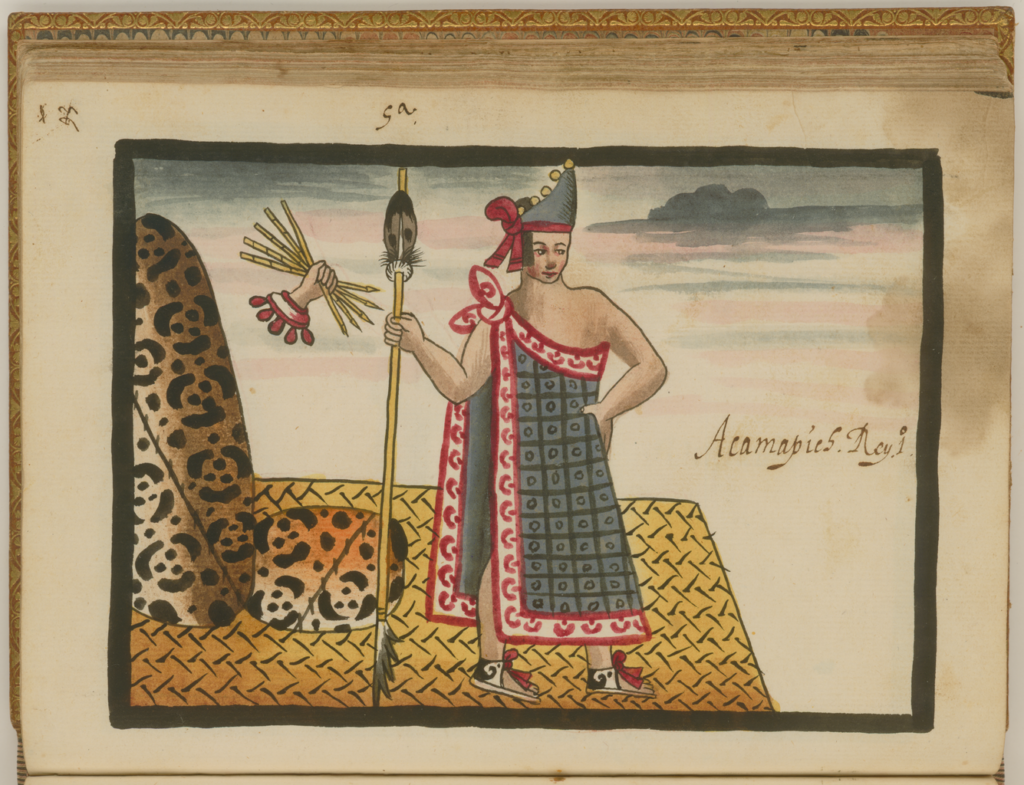Formal Name: Acamapichtzin
Life: Unknown-1395/96
Reign: 1376-1395/96
Name: hummingbird feather
Place of Birth: Possibly Texcoco or Culhuacan.
Died: Likely in Tenochtitlan of illness.
Acamapichtli was not born in Tenochtitlan, and was likely a native of Texcoco or Culhuacan. His name means “fistful of reeds,” and his name glyph used in the many historic codices is essentially that, a fist holding a bundle of reeds.
The council of Mexica elders decided to select Acamapichtli because of his dual Mexica-Colhuacan lineage and so cemented the political place of the newly established island-city of Tenochtitlan. Acamapichtli was crowned and became the first Tlatoani of Tenochtitlan around 1382. His mother being from Culhuacan, the dominant city-state at the time, was a critical consideration in his election. The Mexica were then a minor newcomer in a place with thousands of years of history, they needed status.

The Mexica, and their sister community, Tlatelolco, quickly fell into subjugation by Tezozomoc and the Tepanec people. When Acamapichtli had become ruler he knew he was leading a subjugated people. The Mexica military served Tezozomoc, and helped to enforce his empire. Despite remaining a tributary to the Tepanecs, Acampichtli had set the new Mexica city up for success by expanding the island.
During his reign the city of Tenochtitlan expanded into the lake to the east, and districts were laid out to help plan the growing city. Despite the tribute due to Azcapotzalco the Mexica continued to thrive and grow. In one story from Duran, he tells how Tezozomoc demanded an extraordinary amount of tribute, including fully grown live trees, to be delivered. When the Mexica paid the tribute in full, on time, Tezozomoc was amazed – this story, whether true or some colonial myth – serves to illustrate the productivity of the Mexica people.
Hear about the first rulers of Tenochtitlan:
According to Duran, Acamapichtli’s queen, Ilancueitl, could not conceive a child and each of the lords, including the Aztlan-era founder Tenoch, gave him a daughter. Duran tells of a slave girl so beautiful that despite his queen and many concubines, this slave girl had stolen Acamapichtli’s heart. From her came a baby boy named Itzcoatl, who would become a consequential Tlatoani and one of Acamapichtli’s three descendants to rule. It would be Itzcoatl who would finally free the Mexica from their Tepanec rulers.
The Florentine Codex summarizes Acamapichtli’s reign like this: Acamapichtli was the first lord of Mexico of Tenochtitlan: who had dominion of Mexico, “twenty-one years, all was quiet in the land: and there were no wars in his time.” This is obviously a very over-simplified statement as the Mexica were essentially mercenaries for Tezozomoc. Additionally, the Anales de Tlatelolco indicate he led campaigns against communities on the southern Lake Xochimilco.
During his reign, Acmapichtli laid out the four main districts of Tenochtitlan, including Cuepopan and Moyotlan. Through his physical person and lineage he established the Mexica-Tenochtitlan monarchy, from which the subsequent eight tlatoque would issue. Before his death he also laid out the process on how the next tlatoani should be selected. A council of leaders from the four districts would elect the next ruler, rather than it flow from father to first-born son the council would consider the abilities and persona of the future king.
He seems to have died peacefully, perhaps from illness, around 1400, the date varies by source. According to Duran, Acamapichtli expressed regret that he could not free his people from Tepanec control. From one of his noble wives came a son named Huitzilihuitl, who the new council would select to succeed him. Acamapichtli was buried in a modest grave, it is said, without treasure or slaves as other rulers typically were, due to the humble status of the early Mexica people.
Acamapichtli’s Accomplishments:
Built out the chinampa farming system.
Intermarried with numerous women from neighboring cultures to build family ties.
Created the four main neighborhoods of Tenochtitlan.
Great politician who established Tenochtitlan, politically, in the Valley.
Established a new royal line for Tenochtitlan with every subsequent ruler being a direct descendent until the Contact Period.
Conquered Mizquic, Xochimilco, Cauahnahuac, Cuitlahuac.
Acamapichtli ->> Huitzilihuitzin
